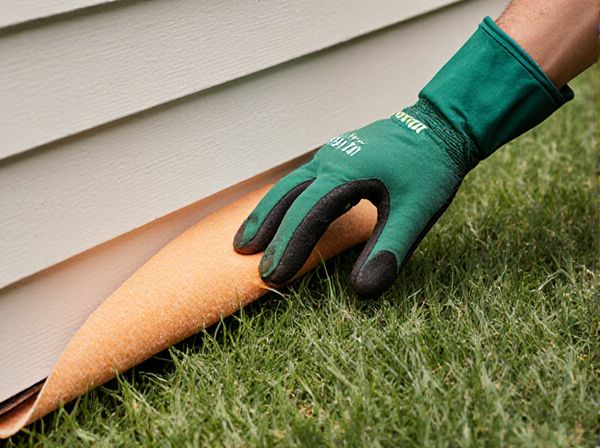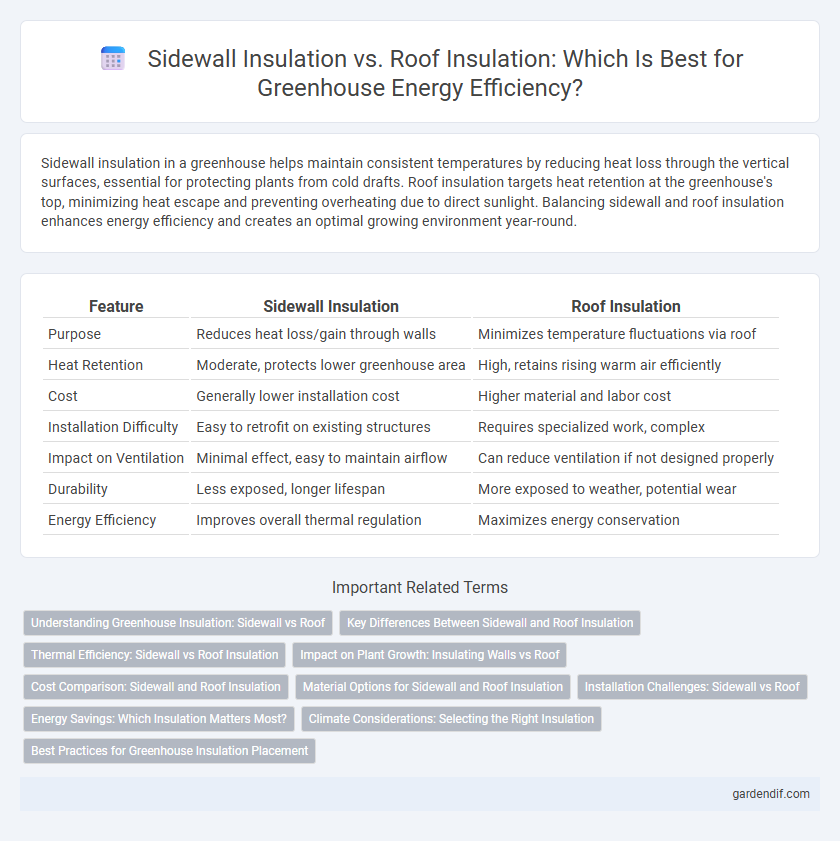
Sidewall Insulation vs Roof Insulation Illustration
Sidewall insulation in a greenhouse helps maintain consistent temperatures by reducing heat loss through the vertical surfaces, essential for protecting plants from cold drafts. Roof insulation targets heat retention at the greenhouse's top, minimizing heat escape and preventing overheating due to direct sunlight. Balancing sidewall and roof insulation enhances energy efficiency and creates an optimal growing environment year-round.
Table of Comparison
| Feature | Sidewall Insulation | Roof Insulation |
|---|---|---|
| Purpose | Reduces heat loss/gain through walls | Minimizes temperature fluctuations via roof |
| Heat Retention | Moderate, protects lower greenhouse area | High, retains rising warm air efficiently |
| Cost | Generally lower installation cost | Higher material and labor cost |
| Installation Difficulty | Easy to retrofit on existing structures | Requires specialized work, complex |
| Impact on Ventilation | Minimal effect, easy to maintain airflow | Can reduce ventilation if not designed properly |
| Durability | Less exposed, longer lifespan | More exposed to weather, potential wear |
| Energy Efficiency | Improves overall thermal regulation | Maximizes energy conservation |
Understanding Greenhouse Insulation: Sidewall vs Roof
Sidewall insulation in greenhouses primarily reduces heat loss through vertical surfaces, improving temperature stability and energy efficiency. Roof insulation targets the top surface, mitigating heat escape during cold weather and minimizing solar heat gain in warmer months. Evaluating climate conditions and greenhouse design helps determine the optimal balance between sidewall and roof insulation for enhanced plant growth and energy conservation.
Key Differences Between Sidewall and Roof Insulation
Sidewall insulation in greenhouses primarily controls heat loss through vertical surfaces, enhancing temperature stability by reducing drafts and external cold impact, while roof insulation focuses on minimizing heat escape through the top, where warm air naturally rises. Sidewall insulation often uses materials like rigid foam panels or reflective films to block lateral heat transfer, whereas roof insulation may incorporate bubble wrap or polycarbonate layers to maximize light diffusion and thermal retention. The choice between sidewall and roof insulation significantly affects energy efficiency, humidity control, and plant growth conditions due to their distinct roles in maintaining the greenhouse microclimate.
Thermal Efficiency: Sidewall vs Roof Insulation
Sidewall insulation in greenhouses significantly reduces heat loss by minimizing thermal bridging through vertical surfaces, enhancing overall energy efficiency. Roof insulation, crucial for retaining warm air that naturally rises, directly impacts temperature stability and reduces heating costs. Optimizing both sidewall and roof insulation with materials featuring high R-values ensures balanced thermal efficiency, maintaining a consistent growing environment year-round.
Impact on Plant Growth: Insulating Walls vs Roof
Sidewall insulation in a greenhouse helps maintain consistent temperature levels around the perimeter, reducing heat loss and minimizing cold drafts that can stress plants, especially during cooler nights. Roof insulation primarily prevents heat escape through the top, where warm air accumulates, supporting stable overhead temperatures critical for photosynthesis. Both insulation methods impact plant growth by creating an optimized microclimate, with sidewall insulation offering better protection against external temperature fluctuations and roof insulation enhancing heat retention from sunlight.
Cost Comparison: Sidewall and Roof Insulation
Sidewall insulation generally costs less per square foot compared to roof insulation due to easier installation and reduced material requirements. Roof insulation involves higher expenses given the complexity of access, increased labor, and the need for materials that withstand extreme temperature variations and potential weather exposure. Budgeting for both should consider long-term energy savings, but upfront costs for roof insulation typically exceed those for sidewall options in greenhouse constructions.
Material Options for Sidewall and Roof Insulation
Sidewall insulation in greenhouses often utilizes rigid foam boards, reflective foil, or polycarbonate panels to maximize thermal retention while allowing sufficient light penetration. Roof insulation materials typically include bubble wrap, polycarbonate sheets, and fiberglass, which balance heat conservation with durability against weather elements. Selecting the right combination of sidewall and roof insulation materials significantly enhances energy efficiency and plant growth by maintaining consistent internal temperatures.
Installation Challenges: Sidewall vs Roof
Sidewall insulation in greenhouses presents challenges such as limited space for materials and potential interference with ventilation systems, making installation more complex. Roof insulation requires working at heights, increasing safety risks and often necessitating specialized equipment for secure placement. Both insulation types demand precise sealing to prevent heat loss, but roof insulation typically involves more intricate structural considerations due to roof slope and exposure.
Energy Savings: Which Insulation Matters Most?
Sidewall insulation in greenhouses significantly reduces heat loss by maintaining stable internal temperatures, directly impacting energy savings during colder months. Roof insulation also contributes to energy efficiency by minimizing heat gain and loss through the largest surface area exposed to external conditions. Prioritizing sidewall insulation typically yields greater energy savings due to its role in preventing drafts and reducing heating costs, but optimal results come from combining both insulation strategies.
Climate Considerations: Selecting the Right Insulation
Sidewall insulation in greenhouses is highly effective in colder climates, as it minimizes heat loss through vertical surfaces exposed to cold winds, enhancing energy efficiency during winter. Roof insulation better suits warmer climates by reducing heat gain from direct sunlight, maintaining cooler internal temperatures and protecting sensitive plants. Optimizing insulation strategies based on climate conditions ensures consistent temperature control, promoting plant health and reducing energy costs.
Best Practices for Greenhouse Insulation Placement
Sidewall insulation in greenhouses primarily helps regulate temperature fluctuations by reducing heat loss through vertical surfaces, while roof insulation targets heat retention by limiting upward heat escape. Best practices recommend prioritizing roof insulation for optimal thermal efficiency due to the natural rise of warm air, complemented by sidewall insulation to enhance overall energy conservation and maintain a stable growing environment. Selecting materials with high R-values and ensuring airtight installation around both sidewalls and roofs maximizes insulation performance and plant health.
Sidewall Insulation vs Roof Insulation Infographic

 gardendif.com
gardendif.com